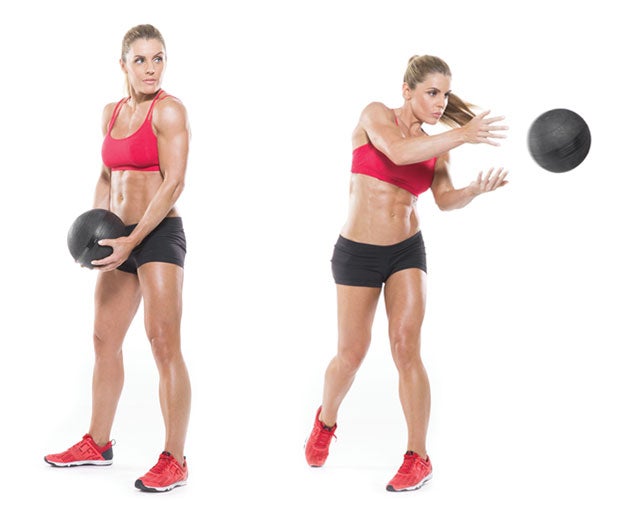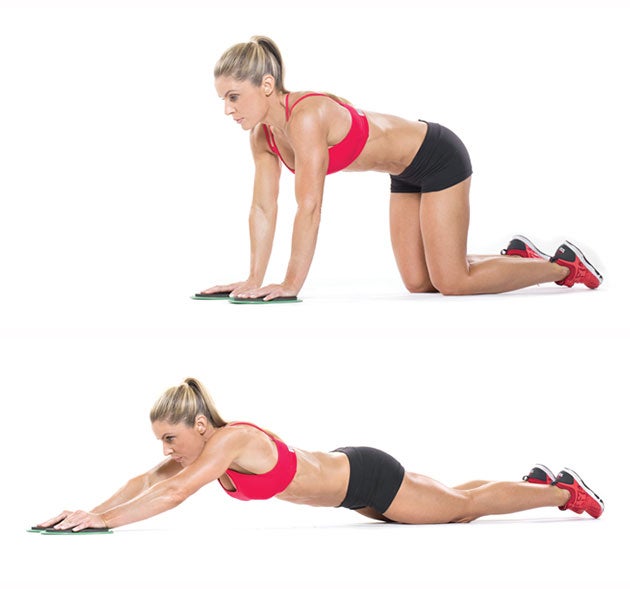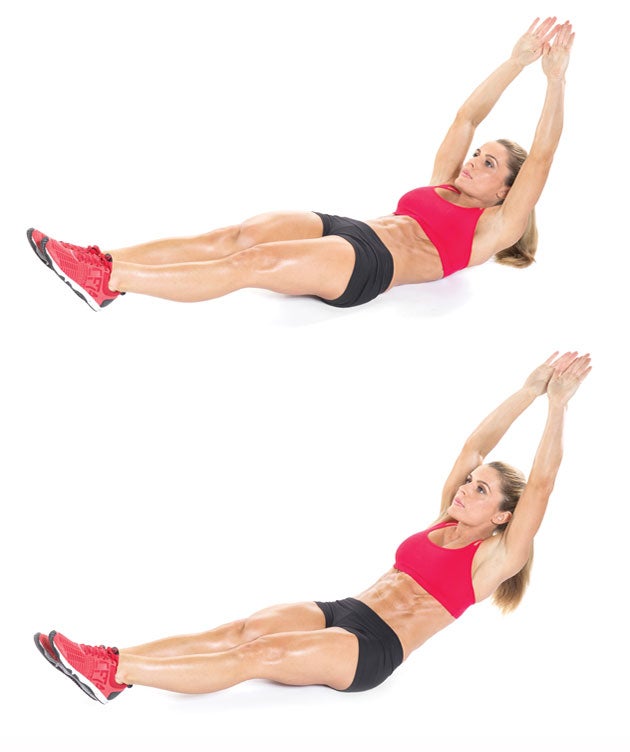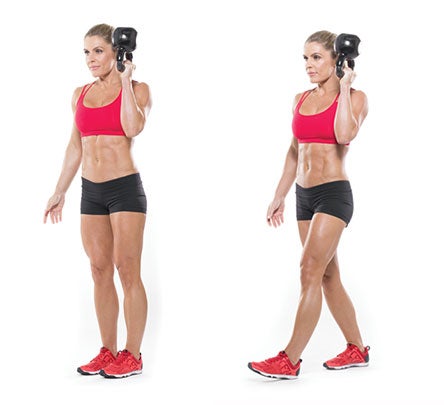Heading out the door? Read this article on the new Outside+ app available now on iOS devices for members! Download the app.
We are all guilty of cherry-picking when it comes to our workouts, of playing to our strengths and choosing the exercises that we find the least uncomfortable. While doing the same workout over and over isn’t as bad as not working out, it’s about as close as you can get to doing nothing.
The body thrives on unfamiliar stimulus, and the abdominals are no different. When you first started training, 20 crunches might have made you sore for days. Now 20 crunches probably feels as strenuous as taking an escalator. Part of the reason is because you are in better shape, but the other reason is you adapted to the stimulus the crunches provide.
With that in mind, we have come up with five abdominal exercises that you are most likely not adapted to, and in fact, are darn near unadaptable. Drop them into your ab routine to mix things up, or combine three or more for a workout that will hit your core muscles and then some.
Medicine-Ball Throw

Why do it: Rotational movements that target the external obliques are like the Khloe Kardashian of ab exercises, always overlooked in favor of their more popular siblings. Not only does a nice set of obliques look incredibly sexy, but they also improve performance in just about any sport, from golf to softball to martial arts. This type of power move, which combines speed with strength, develops the muscles in a different way than static planks or slow-moving crunches.
How to do it: Hold a heavy medicine ball at your waist and stand about 5 feet away from a stable wall. Your right shoulder should be facing the wall and your toes pointed 90 degrees from it. With both hands under the ball, pivot on your left foot and throw the ball into the wall as hard as possible with a two-handed scooping motion. Pick up the ball and repeat for reps before switching sides.
Sets and reps: 4 x 25 reps (two sets each side)
Tempo: As fast as possible while maintaining good form.
Tip: This movement should be done quickly and explosively to maximally stimulate the Type II muscle fibers of the abdominal wall.
Superman Slide

Why do it: This is a great way to challenge not only your anterior and posterior torso but also the stabilizers of your shoulder joint. While any abdominal exercise trains core flexion, this move develops anti-extension, a valuable function and an overlooked way to train your abs.
How to do it: Start on all fours with your knees under your hips and your hands under your shoulders and on a pair of sliders. Begin by sliding your hands away from your body and extending your hips as you lower down toward the ground. Keep your trunk activated throughout the movement, and be sure not to hyperextend your lower back. Don’t worry about going all the way down. Be smart and progress slowly. To return to the start position, engage your abs and drive your hands back toward your body as you slowly slide back up.
Sets and reps: 4 x 8-10
Tempo: Use a 3-1-3 tempo for this, meaning a full three seconds to extend, a one-second hold and then three seconds to retract to the start.
Tip: While we love the Valslides, this can be performed with a cheap pair of $8 furniture movers. Even paper plates or Tupperware lids work well enough on carpeted floors. You also can perform a barbell rollout for a similar effect.
Hollow Rock

Why do it: The hollow rock is a staple of gymnastics conditioning and one of the most functional exercises you can do for your core. Hollow rocks develop midline stability and teach you how to brace the spine, which in turn make you stronger (and safer) at squatting and overhead pressing as well as advanced bodyweight movements like headstands.
How to do it: Lie faceup on the floor with your arms extended and covering your ears and your legs straight and toes pointed. Round your lower back, and lift your feet and hands approximately 12 inches off the floor. You should be shaped like a banana and unable to slide a hand under your lower back. With your lower back acting as a fulcrum, rock your body so your toes dip toward the floor and your shoulders come farther off the ground. Then rock the other way so your feet rise and your torso tilts closer to the ground. Continue that back-and-forth motion for a full 30 seconds.
Sets and reps: 4 x 30 seconds
Tempo: Rock in a slow and controlled motion. The priority is to maintain the hollow-body position, so move as slowly as you need in order to keep the tension on your core.
Tip: If a 30-second interval is too challenging, use numbered reps instead. Start with five reps, rocking forward and backward counts as one full rep.
Bottoms-Up Kettlebell Carry

Why do it: Originally popularized by Dr. Stuart McGill, a professor of spine biomechanics at the University of Waterloo in Ontario, Canada, the one-arm bottoms-up kettlebell carry is like a unilateral vertical plank. It activates muscles in the abdominals, obliques and lower back while also hitting stabilizers in the shoulders, promoting healthy function in the fragile rotator cuff.
How to do it: Grasp a kettlebell by the handle and curl it so it is upside down. Keep your elbow bent and just below shoulder height. Hold your hand close to your chin (or slightly in front of your chin for an extra challenge), and do not allow the elbow to flare out to the side. Keep your trunk braced and your posture tall. Maintain this position as you walk for the prescribed distance. Be sure to perform the movement on both sides. Keep in mind: Because you are holding the weight in a static position, choose a kettlebell that is relatively heavy, between 20 and 30 pounds.
Sets and reps: 4 x 20 yards
Tempo: Take slow and deliberate steps. Rest for 60 seconds between each walk.
Tip: The point of this exercise is to use your contracted core muscles to keep the weight from moving. However, if need be, you may place the fingers of your nonworking hand lightly on the kettlebell to prevent it from shifting in your palm.
Alligator Crawl

Why do it: The alligator crawl is like a plank on creatine. You get the isometric contraction in the abdominals coupled with a dynamic movement in the shoulder girdle and synchronization throughout the posterior kinetic chain. This is a big bang-for-the-buck exercise.
How to do it: On a section of indoor turf or smooth flooring, get into a push-up position with your feet on a weight plate. Experiment with a 10- or 25-pound plate to see what is best for you. Make sure the side of the plate with the lip is facing up and the flat side is facedown. Take a deep breath, flex the muscles in your abdominals and squeeze your glutes. Without lifting your feet, walk forward with your hands, using your toes to drag the plate behind you.
Sets and reps: 4 x 20 feet
Tempo: Use a relatively slow but steady pace
Tip: If pulling a plate on the alligator crawl is too difficult, try it with the Valslides under your feet and work up to using resistance. If you are on a wood floor, you can even do it with a towel under your feet.